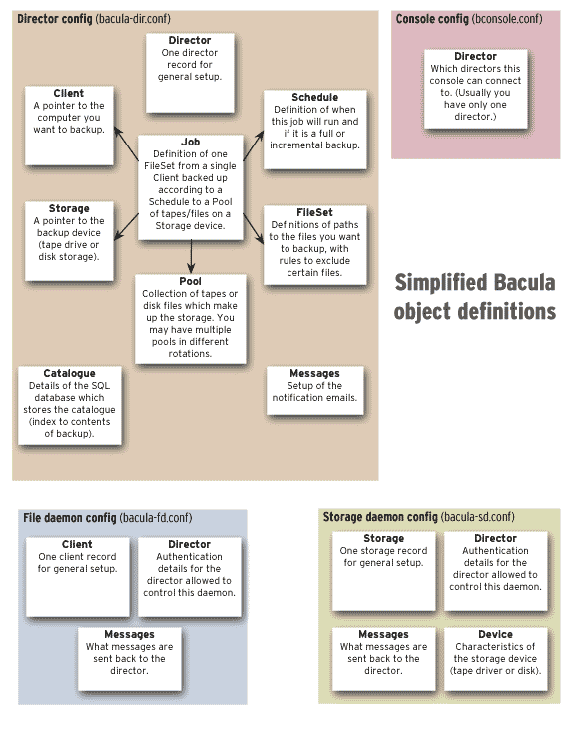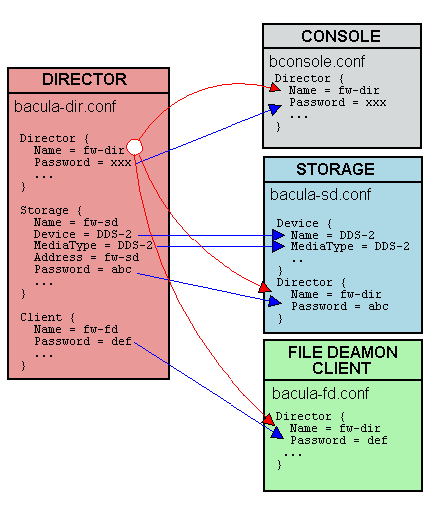Next: Configuring the Director Up: Main Reference Previous: A Brief Tutorial Contents Index
When each of the Bacula programs starts, it reads a configuration file specified on the command line or the default bacula-dir.conf, bacula-fd.conf, bacula-sd.conf, or console.conf for the Director daemon, the File daemon, the Storage daemon, and the Console program respectively.
Each service (Director, Client, Storage, Console) has its own configuration file containing a set of Resource definitions. These resources are very similar from one service to another, but may contain different directives (records) depending on the service. For example, in the Director's resource file, the Director resource defines the name of the Director, a number of global Director parameters and his password. In the File daemon configuration file, the Director resource specifies which Directors are permitted to use the File daemon.
Before running Bacula for the first time, you must customize the configuration files for each daemon. Default configuration files will have been created by the installation process, but you will need to modify them to correspond to your system. An overall view of the resources can be seen in the following:

To ensure that Bacula configuration files can be correctly read including foreign characters the bf LANG environment variable must end in .UTF-8. An full example is en_US.UTF-8. The exact syntax may vary a bit from OS to OS, and exactly how you define it will also vary. On most newer Win32 machines, you can use notepad to edit the conf files, then choose output encoding UTF-8.
Bacula assumes that all filenames are in UTF-8 format on Linux and Unix machines. On Win32 they are in Unicode (UTF-16), and will be automatically converted to UTF-8 format.
Although, you won't need to know the details of all the directives a basic knowledge of Bacula resource directives is essential. Each directive contained within the resource (within the braces) is composed of a keyword followed by an equal sign (=) followed by one or more values. The keywords must be one of the known Bacula resource record keywords, and it may be composed of upper or lower case characters and spaces.
Each resource definition MUST contain a Name directive, and may optionally contain a Description directive. The Name directive is used to uniquely identify the resource. The Description directive is (will be) used during display of the Resource to provide easier human recognition. For example:
Director {
Name = "MyDir"
Description = "Main Bacula Director"
WorkingDirectory = "$HOME/bacula/bin/working"
}
Defines the Director resource with the name "MyDir" and a working directory $HOME/bacula/bin/working. In general, if you want spaces in a name to the right of the first equal sign (=), you must enclose that name within double quotes. Otherwise quotes are not generally necessary because once defined, quoted strings and unquoted strings are all equal.
When reading the configuration file, blank lines are ignored and everything after a hash sign (#) until the end of the line is taken to be a comment. A semicolon (;) is a logical end of line, and anything after the semicolon is considered as the next statement. If a statement appears on a line by itself, a semicolon is not necessary to terminate it, so generally in the examples in this manual, you will not see many semicolons.
Case (upper/lower) and spaces are totally ignored in the resource directive keywords (the part before the equal sign).
Within the keyword (i.e. before the equal sign), spaces are not significant. Thus the keywords: name, Name, and N a m e are all identical.
Spaces after the equal sign and before the first character of the value are ignored.
In general, spaces within a value are significant (not ignored), and if the value is a name, you must enclose the name in double quotes for the spaces to be accepted. Names may contain up to 127 characters. Currently, a name may contain any ASCII character. Within a quoted string, any character following a backslash (\) is taken as itself (handy for inserting backslashes and double quotes (")).
Please note, however, that Bacula resource names as well as certain other names (e.g. Volume names) must contain only letters (including ISO accented letters), numbers, and a few special characters (space, underscore, ...). All other characters and punctuation are invalid.
If you wish to break your configuration file into smaller pieces, you can do so by including other files using the syntax @filename where filename is the full path and filename of another file. The @filename specification can be given anywhere a primitive token would appear.
If you wish include all files in a specific directory, you can use the following:
# Include subfiles associated with configuration of clients.
# They define the bulk of the Clients, Jobs, and FileSets.
# Remember to "reload" the Director after adding a client file.
#
@|"sh -c 'for f in /etc/bacula/clientdefs/*.conf ; do echo @${f} ; done'"
When parsing the resource directives, Bacula classifies the data according to the types listed below. The first time you read this, it may appear a bit overwhelming, but in reality, it is all pretty logical and straightforward.
Any abbreviation of these modifiers is also permitted (i.e. seconds may be specified as sec or s). A specification of m will be taken as months.
The specification of a time may have as many number/modifier parts as you wish. For example:
1 week 2 days 3 hours 10 mins 1 month 2 days 30 sec
are valid date specifications.
The following table lists all current Bacula resource types. It shows what resources must be defined for each service (daemon). The default configuration files will already contain at least one example of each permitted resource, so you need not worry about creating all these kinds of resources from scratch.
| Resource | Director | Client | Storage | Console |
| Autochanger | No | No | Yes | No |
| Catalog | Yes | No | No | No |
| Client | Yes | Yes | No | No |
| Console | Yes | No | No | Yes |
| Device | No | No | Yes | No |
| Director | Yes | Yes | Yes | Yes |
| FileSet | Yes | No | No | No |
| Job | Yes | No | No | No |
| JobDefs | Yes | No | No | No |
| Message | Yes | Yes | Yes | No |
| Pool | Yes | No | No | No |
| Schedule | Yes | No | No | No |
| Storage | Yes | No | Yes | No |
In order for one daemon to contact another daemon, it must authorize itself with a password. In most cases, the password corresponds to a particular name, so both the name and the password must match to be authorized. Passwords are plain text, any text. They are not generated by any special process; just use random text.
The default configuration files are automatically defined for correct authorization with random passwords. If you add to or modify these files, you will need to take care to keep them consistent.
Here is sort of a picture of what names/passwords in which files/Resources must match up:

In the left column, you will find the Director, Storage, and Client resources, with their names and passwords – these are all in bacula-dir.conf. In the right column are where the corresponding values should be found in the Console, Storage daemon (SD), and File daemon (FD) configuration files.
Please note that the Address, fd-sd, that appears in the Storage resource of the Director, preceded with and asterisk in the above example, is passed to the File daemon in symbolic form. The File daemon then resolves it to an IP address. For this reason, you must use either an IP address or a fully qualified name. A name such as localhost, not being a fully qualified name, will resolve in the File daemon to the localhost of the File daemon, which is most likely not what is desired. The password used for the File daemon to authorize with the Storage daemon is a temporary password unique to each Job created by the daemons and is not specified in any .conf file.
The details of each Resource and the directives permitted therein are described in the following chapters.
The following configuration files must be defined: